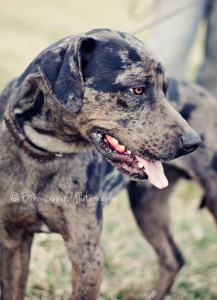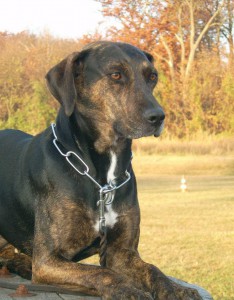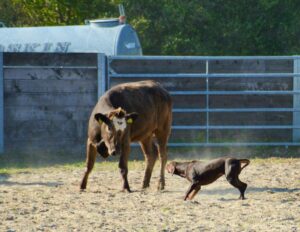Der Louisiana Catahoula Leopard Dog gehört zu den wenigen reinen Arbeitshunderassen. Er ist vom FCI als Rasse nicht anerkannt und in Europa eher selten.. Er wird in seinem Ursprungsland, den USA, als Jagdhund, für die Treibarbeit an Rindern, aber auch als Wachhund für die Farmen gehalten. Er ist ein sehr vielseitiger Arbeitshund.
Der Catahoula wurde um das Jahr 1950 in den USA erstmals offiziell als Rasse registriert.
Seit 1979 ist er „Staatshund“ des Bundesstaates Louisiana – „The Louisiana State Dog“.
Er wird unter anderem zur Drückjagd eingesetzt oder stellt das Wild und verbellt dieses, bis der Jäger beim ihm ist. Er ist ein sogenannter „hot nosed dog“, das heißt, er verfolgt mit Vorliebe die frischeste Spur. Bekannt ist er vor allem für die Jagd auf Wildschweine. Der Catahoula besitzt den hierfür notwendigen Mut und ausreichende Härte. Aufgrund seiner hervorragenden Nase und seines großen Finderwillens wird er auch als Rettungshund (Hochwindsucher oder Mantrailer), Wassersuchhund, Leichenspürhund usw. ausgebildet.
Das „Treeing“ ist ebenfalls eine typische Arbeitsweise des Catahoulas. Dabei treibt er das Wild auf Bäume und hält es dort bis der Jäger da ist. Dabei ist er für sein „auf den Baum laufen“ bekannt. Wichtig ist aber eigentlich das Fixieren des Wildes von unten. Das Baumklettern ist eine spektakuläre Einlage aufgrund seiner hohen Trieblage bei der Jagd und seiner Geschicklichkeit.
Auf den Farmen schätzt man den Catahoula als ausdauernden und harten Arbeiter. Er wird hier neben der Jagd vor allem für die Treibarbeit an Rindern eingesetzt.
Er ist ein sehr vielseitiger und robuster Gebrauchshund. Hervorragende Arbeitseigenschaften wie hohe Intelligenz, große Selbstsicherheit, ausgeprägte Willensstärke und beeindruckende Ausdauer machen das Wesen des Catahoulas ebenso aus, wie Loyalität den „Seinen“ gegenüber und Zurückhaltung gegenüber Fremden. Große Vorsicht gegenüber Unbekanntem und Neuem kann bei einigen Vertretern dieser Rasse vorhanden sein und ist eine durchaus rassetypische Eigenschaft, da im Catahoula noch ein relativ hoher Anteil Wolf vorhanden ist. Das ist nicht zu verwechseln mit Angst. Es ist gesunde Vorsicht! Ebenso ist ein unerschrockenes und furchtloses Wesen durchaus typisch für den Louisiana Catahoula. In der Regel legt er ein ausgeprägtes Territorialverhalten an den Tag und ist sehr wachsam.
Catahoula-Rüden verlangen häufig Respekt von anderen Rüden, das heißt dominantes Verhalten gegenüber der Konkurrenz ist nicht ungewöhnlich.

Indigo Louis Sumici kridla, Farbbeschreibung: Dark patches, Tan Leopard, White Trim, Ring Neck, glass eyes – ein sogenannter patchwork Catahoula mit den typischen blauen Augen
Alle diese Eigenschaften sind natürlich bei jedem Hund unterschiedlich stark ausgeprägt und hängen von der Qualität der Prägung und Sozialisierung, von der Erziehung, den Erfahrungen des Hundes und der Vererbung ab. Sozialisierung spielt eine wichtige Rolle, die Persönlichkeit des Hundes jedoch eine noch größere!
Der Catahoula Leopard Dog ist eine Kreuzung aus Hunden der Native Americans (Indians), Hunden Europäischer Einwanderer und dem Red Wolf.
Genauer gesagt ist diese Rasse entstanden aus Indianerhunden, Beauceron, Mastiff und Greyhound. Es wird davon ausgegangen, dass sich auch der Rote Wolf eingekreuzt hat.
Ihren außergewöhnlichen Namen haben diese Hunde, der Überlieferung nach, von den Indianern aufgrund ihrer blauen Augen bekommen – Catahoula ist ein Wort aus dem indianischen und bedeutet so viel wie „klares/blaues Wasser“. Eine andere These sagt, dass diese Hunde ihren Ursprung in Catahoula Parish im Bundesstaat Louisiana haben. Ein dort gelegener See trägt den Namen Catahoula Lake.
Das Wort „Leopard“ deutet auf die häufig auftretende, auffallende, leopardenähnliche Fleckung des Fells dieser Hunde hin. Es gibt auch ebenso schöne einfarbige Exemplare mit braunen Augen, so genannte „solids“. Alle Farbschläge und Augenfarben sind erlaubt.
Der Catahoula ist eine Merle Gen Rasse. Dies ist bei der Zucht unbedingt zu beachten. Bei der Verpaarung von zwei merlefarbenen Catahoulas werden mit großer Wahrscheinlichkeit auch übermäßig weiße Welpen zu Welt kommen, die ein hohes Risiko für Taubheit haben.
Er ist kein reiner Familienhund, sondern ein Arbeitshund!! Jedoch kann er mit einer ausreichenden und regelmäßigen, seiner Rasse entsprechenden Beschäftigung in der Familie gehalten werden. Er darf nur in erfahrene Hände gegeben werden!
Rassestandard
Deutsche Übersetzung folgt!
HISTORY
The origins of the Louisiana Catahoula Leopard Dog are unknown but it is believed to be descended from crosses between Native American dogs, Red Wolves (some of whom lived as pariahs on the outskirts of Indian villages), and the dogs brought to the New World by Spanish conquistadors, probably mastiff-types and sighthounds. Some experts believe Beaucerons were added to the mix when the area was settled by the French. White settlers in Louisiana found the Native Americans using these unusual-looking dogs to hunt a variety of wild game, including deer, bobcat, wild hog, and bear. The new arrivals soon came to appreciate this versatile breed that was equally capable of scenting, trailing and treeing game, or baying and herding feral hogs and cattle.
There are many stories regarding the origin of the breed’s exotic name: Catahoula. The most likely is that it is a corruption of the Indian word that meant “Choctaw,” the name of a local tribe.
The only thing certain is that the Louisiana Catahoula Leopard Dog is an all-American, multi-purpose working dog. On July 9, 1979, the governor of Louisiana signed a bill making this breed the official State Dog of Louisiana.
The Louisiana Catahoula Leopard Dog was recognized by the United Kennel Club on January 1, 1995.
GENERAL APPEARANCE
The Louisiana Catahoula Leopard Dog is a medium to medium-large, short-coated dog, with a broad head, small-to-medium drop ears, and an undocked tail set on as a natural extension of the topline. The Catahoula is well muscled and powerful, but not bulky, giving the impression of agility and endurance. The Catahoula is a moderate breed and should not resemble either a sighthound or a bulldog in appearance. The body is just slightly longer than tall and the distance from the elbow to the ground should equal 50-60 percent of the dog’s height from the withers to the ground. Because of the breed’s name, many people assume that all Catahoulas have the so-called “leopard” markings and blue eyes. In fact, the breed is noted for its many and unusual coat colors and patterns, as well as varied eye color. The Catahoula should be evaluated as a multi-purpose working dog, and exaggerations or faults should be penalized in proportion to how much they interfere with the dog’s ability to work.
CHARACTERISTICS
Catahoula temperament ranges from serious and business-like when working to clownish at home, with varying levels of energy. It is not uncommon for Catahoulas to be aloof with strangers, which often results in a lack of animation when showing and may cause some to draw away from judges when being examined. Catahoulas should never be excessively aggressive or shy. They can be independent, protective and territorial so they require firm guidance and a clear understanding of their place in the family unit. Catahoulas are affectionate, gentle and loyal family companions.
HEAD
The head is powerfully built without appearing exaggerated. Viewed from the side, the length of skull and muzzle are approximately equal in length, and joined by a well-defined stop of moderate length. The planes of the topskull and the bridge of the muzzle are roughly parallel to one another. There may be a slight median furrow between the eyes and running back to the occipital bone. Gender differences should be apparent in the characteristics of the head.
SKULL – The skull is broad and flat. The cheeks are well developed.
Fault: Excessively broad skull; narrow skull.
MUZZLE – The muzzle is strong and deep. Viewed from above, the muzzle is moderately wide and tapering toward the nose. Lips may be tight or slightly pendulous with pigment of any color or combination of colors.
Faults: Snipey muzzle.
TEETH – The Louisiana Catahoula Leopard Dog has a complete set of evenly spaced, white teeth. A scissors bite is preferred, but a level bite is acceptable. Full dentition is greatly desired, but dogs are not to be penalized for worn or broken teeth.
Serious Faults: Overshot or undershot bite.
NOSE – Nose pigment may be any color or combination of colors.
EYES – Eyes are set moderately well apart, medium in size, somewhat rounded in appearance, and are set well into the skull. Eyes may be any color or combination of colors without preference. Eye rims are tight and may be any color or combination of colors.
Serious Faults: Malformed pupils; pupils not centered; sagging eyelids making haw visible; functional abnormality of eyelids or eyelashes.
EARS – Ears are drop, short to medium in length, moderate in size, and proportionally wide at the base, gradually tapering to the slightly rounded tip. They should fold over and be generally triangular in shape. The top of the ear fold is level or just slightly below the top line of the skull. When the dog is at attention, the inner edge of the ear lies close to the cheek. Laid-back ears are acceptable but not preferred.
Faults: Any ear type other than described above.
Disqualification: Cropped ears.
NECK
The neck is muscular and of good length, without being overdone. The circumference of the neck widens from the nape to where the neck blends smoothly into the shoulders.
Faults: Neck too short and thick or too thin and weak; excess skin forming dewlap.
FOREQUARTERS
The shoulders are strong and smoothly muscled. The shoulder blades are long, wide, flat and well laid back. The upper arm is roughly equal in length to the shoulder blade and joins it at an angle sufficient to ensure that the foot falls under the withers. The elbows are close to the body and do not turn out.
FORELEGS – The forelegs are straight, and of medium bone, indicating strength without excessive thickness. Pasterns are strong, short, and slightly sloping. The length of the forelegs should roughly equal 50-60% of the dog’s height at the withers. A dog with legs shorter than the ideal is to be more heavily penalized than a dog with longer legs.
Faults: Forequarters significantly heavier than hindquarters; bone too heavy or too fine; straight shoulders; out at elbows; weak pasterns.
BODY
A properly proportioned Louisiana Catahoula Leopard Dog is slightly longer than tall. The topline inclines very slightly downward from well-developed withers to a level back. The back is broad and well muscled with a short, strong, slightly arched loin. A slightly longer loin is acceptable in females. The ribs extend well back and are well sprung out from the spine. The chest is deep, reaching at least to the elbows, and moderately broad. When viewed from the side, the forechest extends in a shallow oval shape in front of the forelegs. Tuck-up is apparent, but not exaggerated. Croup is medium to long and slightly sloping. A slightly elevated rear resulting from slightly straighter rear angulation should not be penalized too severely.
Faults: Chest too broad, too narrow or too shallow; soft topline; exaggerated or absent tuck-up; loin too long.
HINDQUARTERS
Hindquarters are strong and smoothly muscled. Width and angulation of hindquarters are in balance with the forequarters. HIND LEGS – The stifles are well bent, and the hocks are well let down. When the dog is standing, the short, strong rear pasterns are perpendicular to the ground and, viewed from the rear, parallel to one another.
Faults: Thin, weak hindquarters; cow-hocked; open-hocked.
FEET
Good feet are essential for a working dog. Feet are well knit and oval in shape. Toes are long, webbed and well arched. Pads are thick and hard. Nails are strong. Dewclaws may be removed.
Fault: Cat foot.
TAIL
The tail is a natural extension of the topline. It is thicker at the base, and tapers to the tip. Natural bob tails are permitted, but not preferred. The natural bob tail, regardless of length, will taper in width from base to tip. A full length tail may be carried upright with the tip curving forward when the dog is moving or alert. When the dog is relaxed, the tail hangs naturally, reaching to the hock joint. Catahoulas should be allowed to carry their tails naturally when being shown. Exhibitors should not hold tails upright.
Faults: Ring tail; docked tail.
Disqualification: Complete absence of a tail (no external coccygeal vertebrae evident.)
COAT
The Catahoula has a single coat, short to medium in length that lies flat and close to the body. Texture ranges from smooth to coarse, without preference.
Disqualifications: Long coat; fuzzy coat that obscures the outline of the dog.
COLOR
Catahoulas come in an endless variety of coat colors and patterns. All color combinations and patterns can have color points or trim, which may be located on the chest, cheeks, above the eyes, on the legs, underbody or under the tail. The Leopard pattern has a base color, with contrasting spots of one or more other colors. Solids have a single coat color. Brindles may have a light or dark base coat color with contrasting stripes. The Patchwork pattern may or may not have one predominant solid color with one or more different size patches of different colors and shades placed randomly on the body. In dogs of equal quality, rich, deep colors are preferable to the lighter colors. However, in evaluating the Catahoula as a true, multi-purpose working dog, coat color is not a primary consideration. No coat color or pattern is preferred.
Serious Fault: 70 percent or more white.
Disqualifications: 90 percent or more white coat color; solid white head; albinism.
HEIGHT AND WEIGHT
Ideal height at maturity for males is 24 inches, and for females, 22 inches, with a variation of two inches either way acceptable. Weight may range from 50 to 95 pounds, in proportion to the dog’s height. The Louisiana Catahoula Leopard Dog must be both powerful and agile so actual weight and height are less important than the correct proportion of weight to height. Catahoulas should always be presented in hard, working condition. Any deviation from the ideal must be judged by the extent of the deviation, and the effect it has on the dog’s ability to work.
GAIT
When trotting, the gait is smooth, fluid and effortless, showing good but not exaggerated reach in front and powerful drive behind. The topline remains level with only a slight flexing to indicate suppleness. Viewed from any position, legs turn neither in nor out, nor do feet cross or interfere with each other. As speed increases, feet tend to converge toward center line of balance. Poor movement should be penalized to the degree to which it reduces the Catahoula’s ability to perform the tasks it was bred to do.
DISQUALIFICATIONS
Unilateral or bilateral cryptorchid. Viciousness or extreme shyness. Unilateral or bilateral deafness. Cropped ears. Long coat. Fuzzy coat that obscures the outline of the dog. 90 percent or more white coat color. Solid white head. Albinism. Complete absence of a tail (no external coccygeal vertebrae evident.)
.




